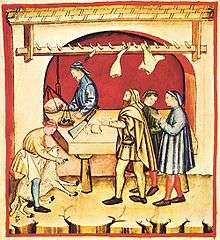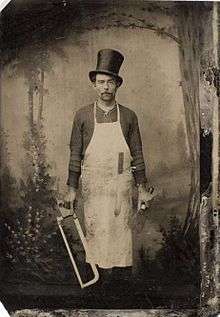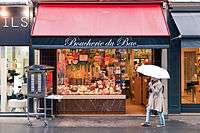Butcher
 A butcher in Charlottesville, Virginia, United States in 2015 | |
| Occupation | |
|---|---|
Occupation type | Vocation |
Activity sectors | Manufacturing |
| Description | |
Fields of employment | Retail |
Related jobs | Animal husbandry |

A butcher is a person who may slaughter animals, dress their flesh, sell their meat, or participate within any combination of these three tasks.[1] They may prepare standard cuts of meat and poultry for sale in retail or wholesale food establishments. A butcher may be employed by supermarkets, grocery stores, butcher shops and fish markets, slaughter houses, or may be self-employed.[2]
An ancient trade, whose duties may date back to the domestication of livestock, butchers formed guilds in England as far back as 1272.[3] Today, many jurisdictions offer trade certifications for butchers. Some areas expect a three-year apprenticeship followed by the option of becoming a master butcher.[4][5]
Duties


Butchery is a traditional line of work. In the industrialized world, slaughterhouses use butchers to slaughter the animals, performing one or a few of the steps repeatedly as specialists on a semiautomated disassembly line. The steps include stunning (rendering the animal incapacitated), exsanguination (severing the carotid or brachial arteries to facilitate blood removal), skinning (removing the hide or pelt) or scalding and dehairing (pork), evisceration (removing the viscera) and splitting (dividing the carcass in half longitudinally).
After the carcasses are chilled (unless "hot-boned"), primary butchery consists of selecting carcasses, sides, or quarters from which primal cuts can be produced with the minimum of wastage; separating the primal cuts from the carcass; trimming primal cuts and preparing them for secondary butchery or sale; and storing cut meats. Secondary butchery involves boning and trimming primal cuts in preparation for sale. Historically, primary and secondary butchery were performed in the same establishment, but the advent of methods of preservation and low cost transportation has largely separated them.
In parts of the world, it is common for butchers to perform many or all of the butcher's duties. Where refrigeration is less common, these skills are required to sell the meat of slaughtered animals.
Butcher shop

Some butchers sell their goods in specialized stores, commonly termed a butcher shop (American English), butchery (South African English) or butcher's shop (British English). Butchers at a butcher shop may perform primary butchery, but will typically perform secondary butchery to prepare fresh cuts of meat for sale. These shops may also sell related products, such as hot food (using their own meat products), food preparation supplies, baked goods and grocery items. Butcher shops can have a wider variety of animal types, meat cuts and quality of cuts. Additionally, butcher shops may focus on a particular culture, or nationality, of meat production. Some butcher shops, termed "meat delis", may also include a delicatessen.[6]
In the United States and Canada, butcher shops are becoming less common because of the increasing popularity of supermarkets. Supermarkets employ butchers for secondary butchery, but in the United States even that role is diminished with the advent of "case-ready" meat, where the product is packaged for retail sale at the packinghouse or specialized central processing plants.
Primal cut
A primal cut is a piece of meat initially separated from the carcass during butchering. Different countries and cultures make these cuts in different ways, and primal cuts also differ between type of carcass. The British, American and French primal cuts all differ in some respects. A notable example is fatback, which in Europe is an important primal cut of pork, but in North America is regarded as trimmings to be used in sausage or rendered into lard. The primal cuts may be sold complete or cut further.
(The quite distinct term "prime cut" is sometimes used to describe cuts considered to be of better quality; for example the USDA uses a beef grading system ranging from "prime" to "canner".[7])
Metaphorical use
- See also Butcher (disambiguation)
In various periods and cultures, the term "butcher" has been applied to people who act cruelly to other human beings or slaughter them. For example, Pompey, a prominent Roman general and politician of the first century BC, got the Latin nickname adulescentulus carnifex, translated as "The Teenage Butcher" or "The Butcher Boy", due to brutal treatment of political opponents in the early part of his career.
See also
References
- ↑ "Merriam-Webster's Dictionary's definition of "butcher"".
- ↑ "Employment information for butchers".
- ↑ "York Butchers' Guild". Yorkbutchersgild.com. Archived from the original on 2012-03-08. Retrieved 2012-04-04.
- ↑ "Job futures statistics". Servicecanada.gc.ca. Archived from the original on 2009-08-07.
- ↑ "Master Butcher's Guide". Members.shaw.ca. Archived from the original on 2006-09-23.
- ↑ sameatshops.ca
- ↑ USDA beef grading system Archived 2013-01-22 at the Wayback Machine.

